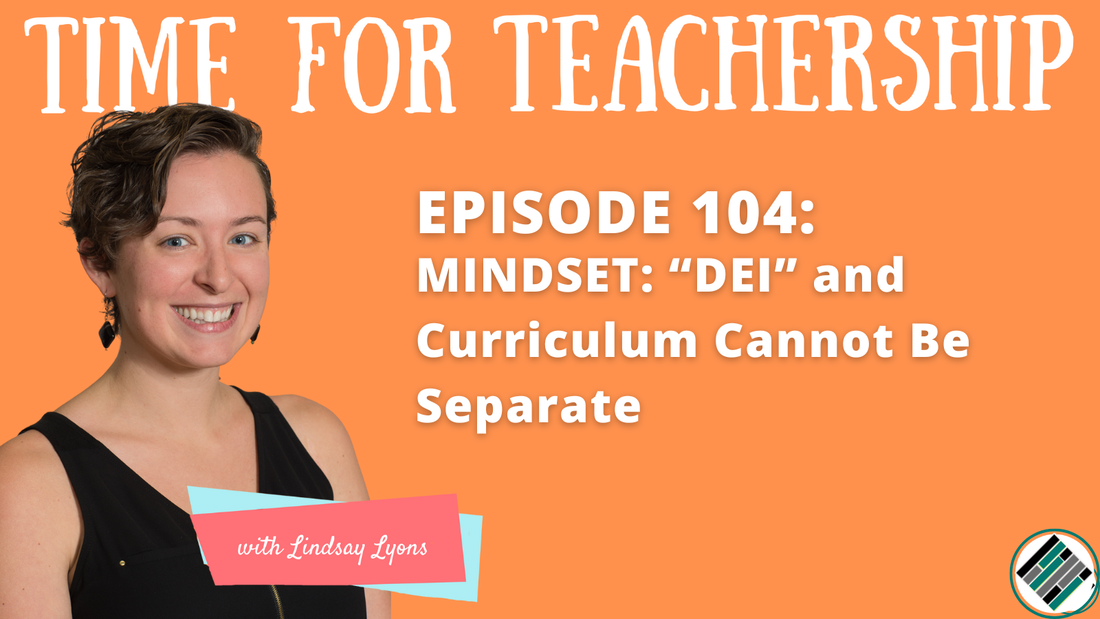
Listen to the episode by clicking the link to your preferred podcast platform below:
Diversity, Equity, and Inclusion is often siloed as something separate from the day-to-day curriculum and instruction that occurs in schools. This doesn’t work. Curriculum needs to be designed with justice and belonging at the core.
Why? DEI is too often siloed from curriculum and instruction. It must be embedded in our curriculum work to be sustainable and make lasting change. Too often I see educators using the “add diversity and stir” approach (to go off of Sandra Harding’s “add women and stir” critique from the 1990’s. Here are 3 ways to bridge the current gap between “DEI” work and curriculum design… Develop a pedagogy of student voice. Dugan and Safir talk about this in their amazing book, Street Data. They write, “Equity work is first and foremost pedagogical” (p. 4). They explain student agency is critical to healing from and transforming oppression, and they cite research that shows agency is one of the most significant factors in restoring well-being for marginalized groups (p. 104). I share an overview of their 6 “rules” in the episode, but I’ll highlight one key point here: learners should be engaged in conversation with their peers a minimum of 75% of each class time. This should be a district-wide “look for.” To help make this a reality, we can help each team define and refine the highest-leverage discussion-based protocols they use. Design Driving Questions and Projects That Advance Justice. Our unit questions (or driving questions) and summative assessments should have a purpose beyond the grade and an audience beyond the teacher. To make sure students are interested in the topic or project, co-create the projects with students. Invite students to creatively apply what they learn in class to actually advance justice in their communities. Curate Resources and Content that Affirms Students’ Identities. In doing this, make sure students’ multiple, intersecting identities, experiences, aspirations, and (hi)stories are reflected and affirmed. We want to avoid treating demographic categories as monolithic, and represent various intersections with depth—beyond a “single story” (Ngozi Adichie). We can also invite students and families to share resources or their own expertise as part of the curriculum. Note: this should be an invitation, not an expectation. We don’t want to put our work on our students or their families. Final Tips Curriculum Directors or Assistant Superintendents of Curriculum and Instruction, partner with your DEI counterparts (e.g., Assistant Superintendent of Diversity, Equity, and Inclusion). Share funding sources, and co-plan professional learning experiences. Don’t separate the DEI Task Force and Curriculum Committee meetings. Every committee should be a DEI committee. At the bare minimum, if it must be separate, each committee—including the Curriculum Committee—should have a member on the DEI committee. Remember: Sustainable, embedded approaches to what we do (i.e., curriculum and instruction) will go so much further in advancing educational equity than one-off initiatives. If you’re ready to audit your curriculum for justice, sign up for a complementary Curriculum Audit from me or choose to DIY it with my mini course. If you’re interested in the book, Street Data, you can get it here. And, if you’re looking for more details on the ideas in this blog post, listen to episode 104 the Time for Teachership podcast. If you’re unable to listen or you prefer to read the full episode, you can find the transcript here. Quotes:
Want to learn more about justice based curricula? Watch this video below:
0 Comments
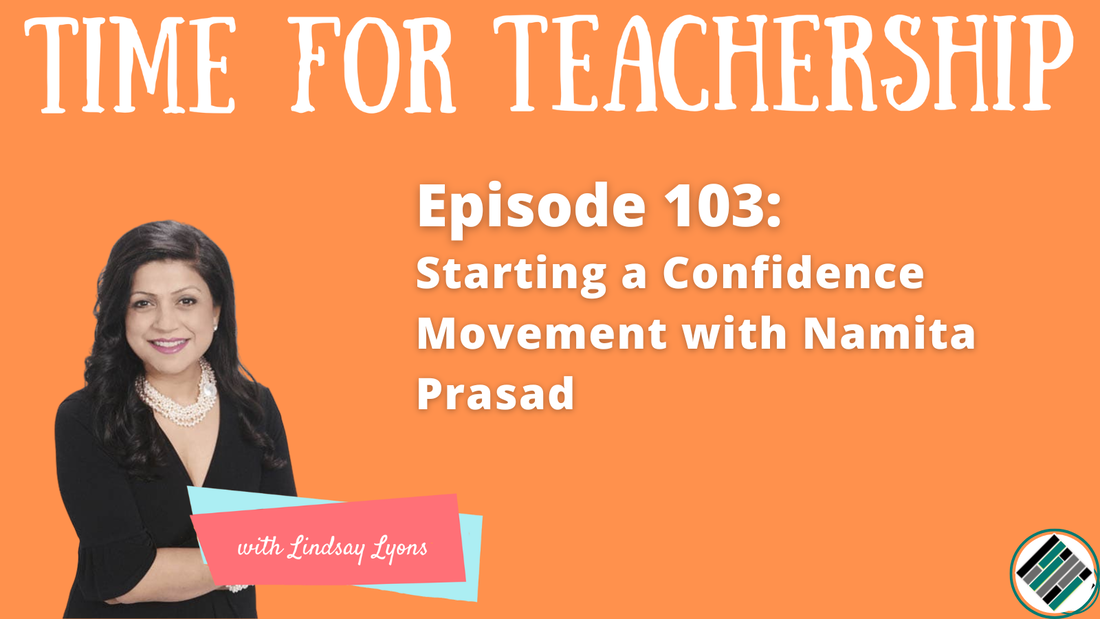
Listen to the episode by clicking the link to your preferred podcast platform below:
Namita Prasad is a confidence educator. When times were tough in her life she has had to rely on the “why not” or “Confident Mindset” approach that her father instilled in her as a child. She and her team created a school program so that all children understand how to become confident. Today, we talk about her approach to teaching confidence!
The Big Dream Educators and caretakers will believe and adopt the approach that, “No one is born confident, but anyone can become confident.” She’s excited for this dream to turn into a reality within a few years! Namita found confidence means different things to different people. So, she and her team define confidence as: A feeling that you don’t start out with. You get the feeling after actions of practice. Alignment to the 4 Stages: Mindset, Pedagogy, Assessment, and Content A culture of relationship-building is a good foundation for this work. Namita suggests a quick, powerful practice called the One-Word Check-In. Adults can ask each child as they enter the school or class or home how they feel in one word. Additionally, the culture should foster 3 pillars: courage, character, and commitment. Student voice is a major part of Namita’s ACM (A Confident Mindset) Program. In the program, students self-evaluate and tell adults their strengths, areas for growth, and fears. They develop their action plan and create their own Circle of Confidence (in step 6), which includes identifying people who are their “rocks” and “champions” and asking if each of those people are willing to be part of their Circle of Confidence. ACM’s 6 Steps:
Namita’s tip for giving feedback: In 2 minutes:
Namita believes A Confident Mindset is critical for us to be able to face the challenging realities of the world. She says it’s most effective when we all take this approach as adults and children in all areas of our lives. Challenges Adults often put lots of pressure on ourselves and think we can’t help children be confident if we are not confident ourselves. That’s not required! We can learn with our children. Another challenge is thinking we are too busy to do this work, but it’s actually a one-time “forever change,” in our mindset that we can keep practicing in all the things we regularly do. One Step to Get Started Ask yourself: What is YOUR “Why not?” Then, go practice! Remember: Mindset comes before skill set. First, have a confident mindset or a mindset that’s positive and then try to learn a skill set. Stay Connected You can find this week’s guest on her website and Facebook. To help you implement A Confident Mindset, Namita is sharing tons of free resources with you. And, if you’re looking for more details on the ideas in this blog post, listen to episode 103 of the Time for Teachership podcast. If you’re unable to listen or you prefer to read the full episode, you can find the transcript here. Quotes:
If you enjoyed this episode, you may also want to check out this video on student voice in decision making:
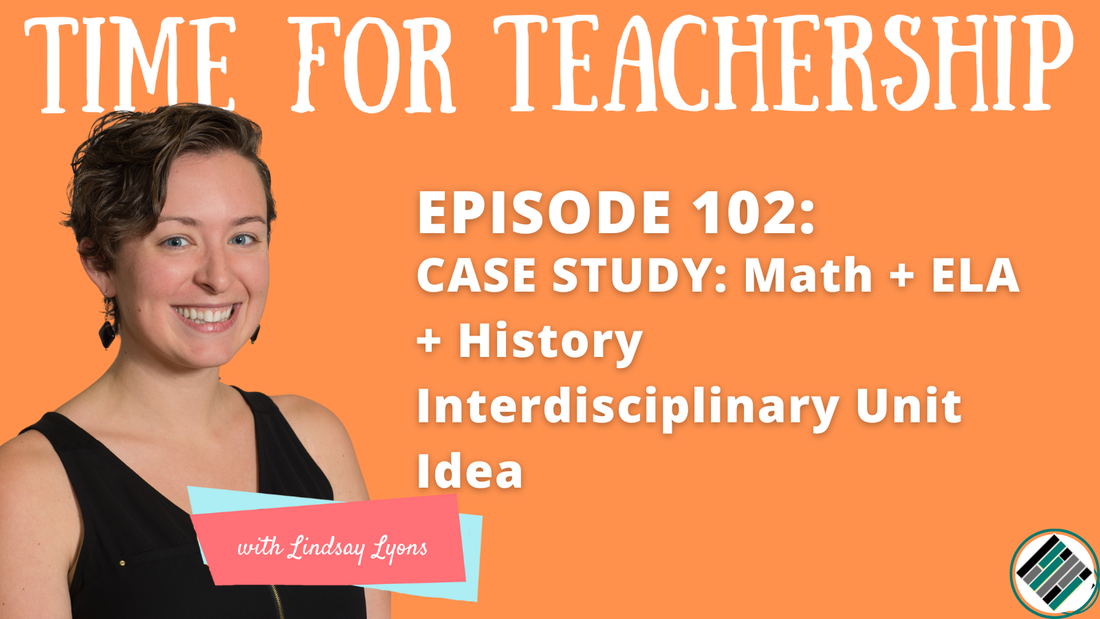
Listen to the episode by clicking the link to your preferred podcast platform below:
I love the idea of inviting listeners and readers to share an idea for an interdisciplinary unit idea. If you’re interested in sharing a topic, question, or resource you want to develop a unit around or coach teachers to develop a unit around, let me know in the comments below or reach out via email. This episode is a glimpse into my own brain’s process of taking a unit idea from a text I heard (and loved) to a full unit outline.
Why support the design of interdisciplinary units? From the research (and from practice), we know interdisciplinary units deepen understanding and nurtures students’ creative genius. Interdisciplinary unit questions and projects enable students to make connections and innovative applications relevant to their lives. This means learners are more engaged than in a siloed curriculum. Finally, it presents a wider range of options for students to advance justice in different areas and supports what Westheimer and Kahne call “justice-oriented citizenship.” Inspiration to Interdisciplinary Unit Outline: What is the process? Note: For context, I’m envisioning a Math, ELA, and Social Studies interdisciplinary unit, so I’ll brainstorm with those content areas in mind. Step 1: Inspiration. I was inspired by a poem by 2018 MacArthur Fellow, Natalie Diaz, called, “American Arithmetic.” Step 2: Brainstorm Initial Connections to Subjects. ELA: Literary choices and connections to lived experience and emotion. Social Studies: Histories and present day perspectives of indigenous people, the origins of the concept of race, and systems of governance and equitable representation. Math: Students’ experiences of math. Step 3: Essential Question. This is a year-long question that is relevant in all of a year’s units, even each lesson can connect to the EQ. Possible EQ: Is math more likely to mask injustice or make it visible? In a math class, we can visibility to statistics, geometry (e.g., gerrymandering), algebra (e.g., intersectionality). Step 4: Driving Question. This is a unit-specific question. In an interdisciplinary unit, this is used in all classes. Possible Question: What is the most powerful strategy to advance justice for indigenous peoples: math, language/poetry, or history? This enables students to create an argument for the subject area they most gravitate toward. Step 5: Project Idea. The project is the way students can answer/address the DQ. Possible idea: Performance poetry with math visuals in background. (I’m thinking something similar to how Hasan Minaj used visual graphs and images to do political commentary on his show, Patriot Act. Step 6: Lesson-Specific Activities or “Texts.” I aim for one “text” (resource) and one protocol (activity) per lesson. Possible text ideas: clips from Hasan Minaj’s show Patriot Act (use for project medium inspiration); Dr. John Littlewolf’s poem (he read this on episode 34 of the podcast); research on the longstanding injustice of Missing and Murdered Indigenous Women and Girls; and Native-Land.Ca to have students research the land their community occupies. Final Tip Coach each teacher to develop a student-centered unit arc first. This will make it much easier to create new curriculum and build interdisciplinary units.
In lieu of a free resource, I’m inviting you to share a topic, resource, or question that you want to think through. Share your idea or question in the comments below. I might feature it on an episode (or invite you on, if that’s your jam!) And, if you’re looking for more details on the ideas in this blog post, listen to episode 104 the Time for Teachership podcast. If you’re unable to listen or you prefer to read the full episode, you can find the transcript here. Quotes:
Want to continue learning more about curriculum development and implementation? Watch this video on how to develop district curriculum that challenges, affirms, and inspires:
2/6/2023 101. Teaching History for Justice with Dr. Kaylene Stevens and Dr. Christopher MartellRead Now
Listen to the episode by clicking the link to your preferred podcast platform below:
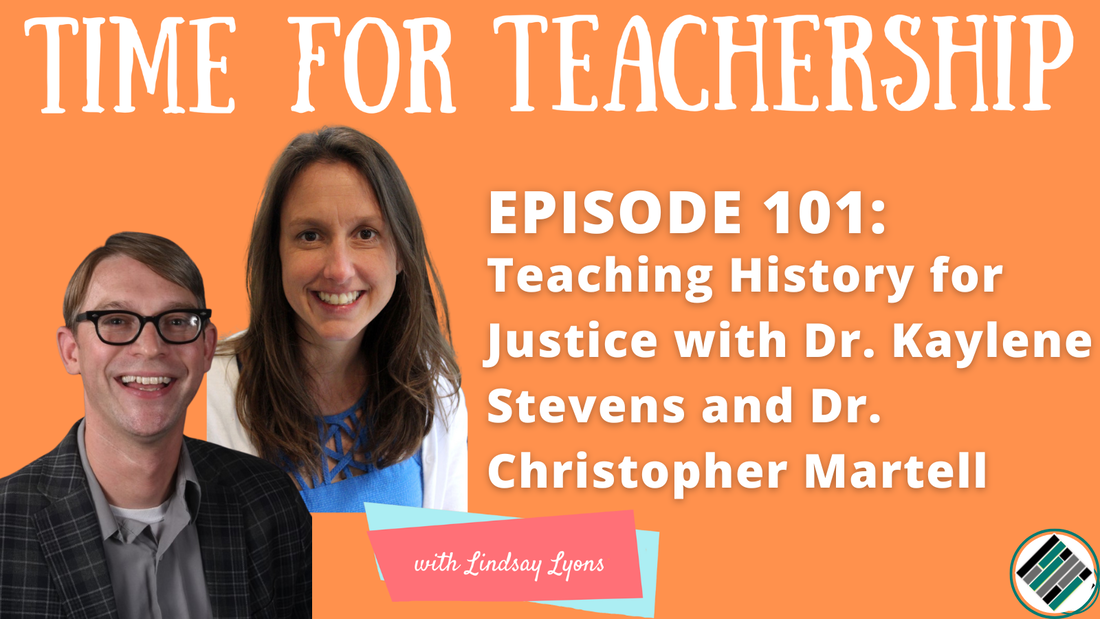
Former social studies teachers, current university professors, and co-authors of the book "Teaching History for Justice: Centering Activism in Students' Study of the Past,” Dr. Kaylene Stevens and Dr. Christopher Martell talk about how and why we need to teach justice, activism, and movement building in schools. They jump right into the conversation by giving credit to all of the teachers they’ve researched and learned with. I absolutely loved their book, so it’s no surprise I also loved this conversation.
The Big Dream The values of our country will change if we teach for justice! Survey data shows that the majority of people in power in the United States think everything’s okay (i.e., race, gender, and class-based oppression are not issues.) Most teachers are still white despite most students being students of color, so there’s hope that white teachers can be activists and antiracists. Alignment to the 4 Stages: Mindset, Pedagogy, Assessment, and Content Mindset is foundational for all of the other stages. Each of the stages are like buckets. The book is intended to be practical, offering a “how” to teach for justice, which is often overlooked in academia. Kaylene encouraged educators to think deeply about the content addressing justice and joy. Chris pointed out these 4 buckets can be done in an anti-oppressive way or an oppressive way. So, educators can be self-reflective and thoughtful about our positionalities. Their framework also supports a problem-solving pedagogy (Freire). Given oppressive laws and book-banning, it’s important to know the context in which you work and identify allies to do this work collectively. We can start local! We want to teach our students to be activists, but we don’t necessarily need to tell them what to care about. It’s about teaching students to use the levers of democracy to make changes. Teachers can be renegades (Agarwal-Rangnath) or subversives depending on the context and limitations of your state’s legislation. Teaching is a political act. It doesn’t need to be partisan. We do this for the students! Action Steps Step 1: Communicate with families and caretakers. If families are concerned, listen to those individuals. After a conversation, families often realize Step 2: Create or join a community of educators/learners. Reach out to others who are doing this work. Listen to BIPOC teachers. Pick one text a year on a topic that you don’t know a lot about. Get students out in the community (e.g., field trips, invite community members into class as guests, family/community interviews). Research shows one of the biggest ways to combat “-isms” is exposure. Step 3: Trust students. Students can use the tools of doing historian work to make the world a better place. We should try to get schools to look more like life than machines. We need to be comfortable with students wanting to change our society’s systems. We can invite debate-oriented pedagogy and give students a chance to bring their own opinions into the class. One Step (or Two) to Get Started Figure out where you are and go from there. Read one of the recommended books below! Think about the complexity of our social identities (and the intersectionality of these identities) as we plan curriculum and do this work. Stay Connected You can find this week’s guests on the following platforms: Dr. Kaylene Stevens:
Dr. Christopher Martell:
Referenced Links and Recommended Readings: Teaching History for Justice book Racial Literacies and Social Studies book Critical Race Theory and Social Studies Futures book Intersectionality Matters podcast Visions of Education podcast episode with Dr. Kaylene Stevens Bettina Love website To help you implement teaching for justice, I’m sharing my _____ with you for free. And, if you’re looking for more details on the ideas in this blog post, listen to episode 101 of the Time for Teachership podcast. If you’re unable to listen or you prefer to read the full episode, you can find the transcript here. Quotes:
Want to continue learning more about teaching history for justice? Watch this video on culturally responsive and sustaining education:
|
Details
For transcripts of episodes (and the option to search for terms in transcripts), click here!
Time for Teachership is now a proud member of the...AuthorLindsay Lyons (she/her) is an educational justice coach who works with teachers and school leaders to inspire educational innovation for racial and gender justice, design curricula grounded in student voice, and build capacity for shared leadership. Lindsay taught in NYC public schools, holds a PhD in Leadership and Change, and is the founder of the educational blog and podcast, Time for Teachership. Archives
May 2024
Categories |
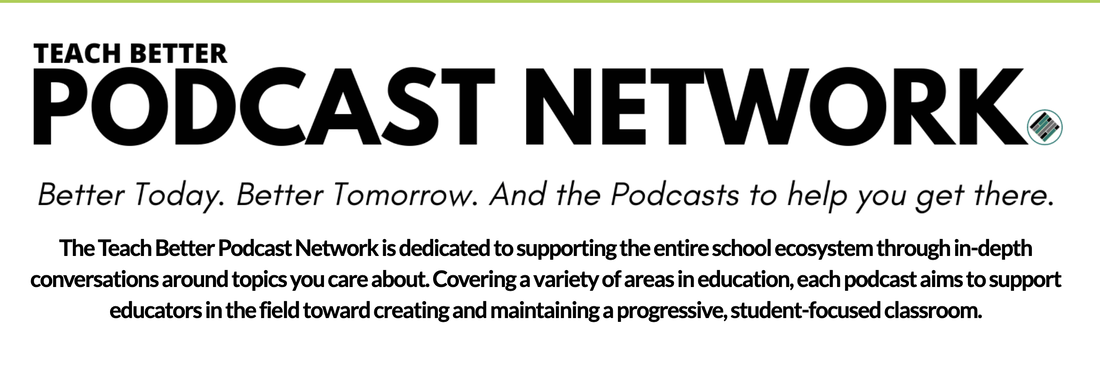
 RSS Feed
RSS Feed